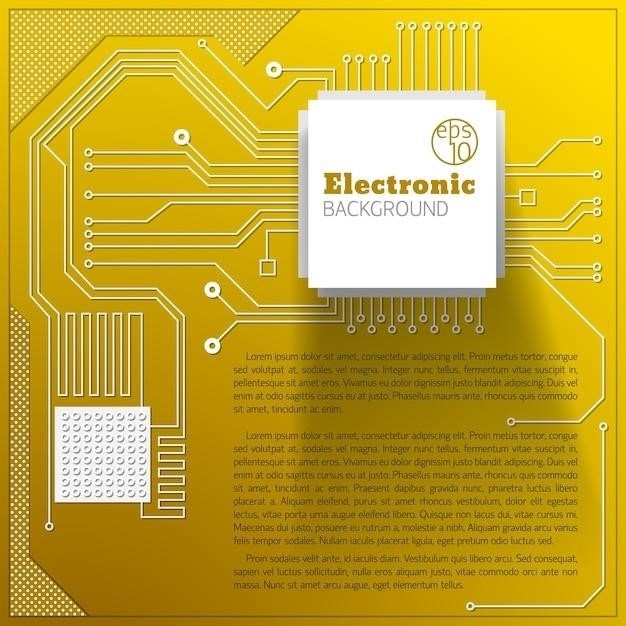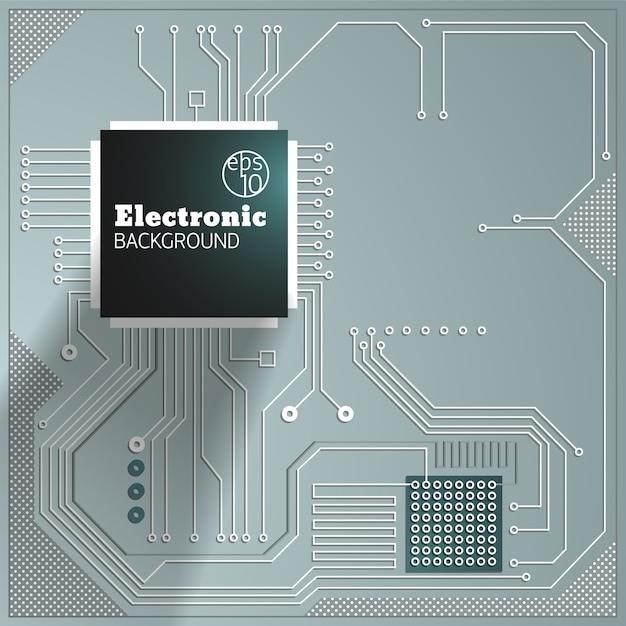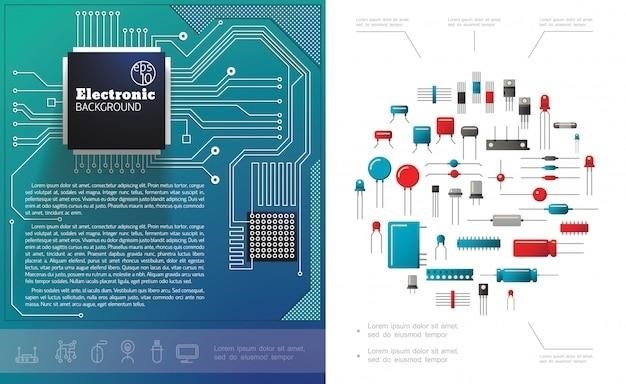
Understanding Circuit Diagrams
Circuit diagrams, often found as PDFs, visually represent electrical circuits. They use symbols to denote components and lines to show connections, facilitating understanding and analysis of circuit functionality. These diagrams are crucial for design, troubleshooting, and documentation.
Types of Circuit Diagrams
Several types of circuit diagrams exist, each serving a specific purpose. Schematic diagrams provide a symbolic representation of the circuit’s components and their interconnections, focusing on functionality rather than physical layout. These are commonly used for design and analysis. Conversely, wiring diagrams prioritize the physical arrangement of components and connections, emphasizing spatial relationships. They are essential for construction and maintenance. Block diagrams offer a high-level overview, representing the circuit as interconnected functional blocks without detailed component specifics. These are useful for initial design conceptualization and system-level understanding. Ladder diagrams, frequently found in industrial control systems, illustrate the logic of electrical circuits using standard symbols. They are particularly effective in depicting sequential operations and control pathways. The choice of diagram type depends on the specific application and the level of detail required.
Line Diagrams
Line diagrams, also known as ladder diagrams, offer a simplified representation of electrical circuits, prioritizing logical connections over precise physical layouts. They utilize standardized symbols to denote components and connections, making them easily understandable even without extensive electrical knowledge. This visual clarity is particularly beneficial in industrial control systems, where understanding the sequence of operations is paramount. Line diagrams effectively illustrate the flow of signals and power through the circuit, highlighting the relationships between components and their roles in the overall system function. They are commonly used for troubleshooting and maintenance, allowing technicians to quickly trace signal paths and identify potential issues. The simplicity and clarity of line diagrams make them an essential tool for both design and practical application in numerous industrial settings.
Schematic Diagrams
Schematic diagrams provide a detailed, symbolic representation of an electrical circuit’s components and their interconnections. Unlike line diagrams that focus on logical flow, schematics prioritize the precise arrangement and relationships of individual components. Each component is represented by a standardized symbol, and connections are shown with lines indicating the wiring paths. This level of detail makes schematics essential for circuit design, analysis, and simulation. They are frequently used in conjunction with circuit simulation software to verify circuit behavior before physical construction. The standardized symbols used in schematic diagrams ensure universal understanding across different technical disciplines and geographical locations. PDF versions of schematics are widely shared and archived, ensuring easy accessibility and collaboration among engineers and technicians worldwide. Careful interpretation of schematics is crucial for both understanding and modifying existing circuits.

Reading Circuit Diagrams
Interpreting circuit diagrams, often in PDF format, involves understanding component symbols, tracing connections, and following signal flow to grasp circuit operation.
Interpreting Symbols
A crucial step in understanding circuit diagrams, frequently accessed as PDFs, is deciphering the symbols used. These symbols represent various electrical and electronic components, such as resistors, capacitors, transistors, and integrated circuits. Each symbol has a specific meaning and visual representation. Familiarity with these symbols is essential for interpreting the diagram’s layout and functionality. Standard symbols are used across different diagrams and software, ensuring consistency in representation. Reference guides or online resources provide comprehensive listings of standard symbols and their corresponding components. Understanding these symbols allows for accurate identification of components and their roles within the circuit, forming the foundation for comprehensive analysis.
Understanding Connections
Analyzing connections within circuit diagrams, often presented as PDFs, is key to comprehending circuit operation. Lines in the diagram represent the physical connections between components. These lines indicate how current flows through the circuit, showing the path from power source to components and back. Careful observation reveals series and parallel connections, influencing voltage and current distribution. Junctions where multiple lines meet indicate points of connection between components. Understanding connection types helps determine how components interact, affecting overall circuit behavior. Tracing the flow of current from source to load helps understand the function of each component. Analyzing connections is fundamental to comprehending the circuit’s logic and intended functionality. Correct interpretation of these connections is crucial for accurate analysis and troubleshooting.
Following the Flow
Tracing the current’s path in a circuit diagram, frequently available as a PDF, is essential for understanding its operation. Begin at the power source, typically a battery or power supply, symbolized by specific icons. Follow the lines representing wires, observing how they connect components. Note the direction of current flow, usually indicated by arrows or the implied direction from positive to negative terminals. Each component influences the flow; resistors impede current, capacitors store charge, and transistors act as switches or amplifiers, altering the flow’s path and intensity. Pay attention to junctions, where multiple paths converge or diverge, as these influence current distribution. A systematic approach, following each branch of the circuit, clarifies the overall functionality. This process reveals how different components interact to achieve the circuit’s purpose, from simple signal processing to complex logic operations.
Creating Circuit Diagrams
Software like Circuit Diagram offers online tools and desktop applications for designing and generating circuit diagrams, often saved as PDFs for easy sharing and archiving.
Software Options
Numerous software applications facilitate the creation of circuit diagrams, ultimately exportable as PDFs. Dedicated circuit design software packages offer advanced features like schematic capture, simulation, and automated component placement, streamlining the design process. These professional-grade tools often include libraries of standard symbols, ensuring consistency and clarity in the final diagram. However, simpler options exist for those with less complex needs; free online tools and web-based editors provide a user-friendly interface for basic circuit diagrams. These online editors often allow for direct PDF export, making sharing and collaboration straightforward. The choice of software depends heavily on the complexity of the circuit and the user’s technical expertise. For intricate designs, a powerful, dedicated software suite is recommended, while for simpler projects, a free online tool may suffice. Regardless of the choice, the resulting PDF ensures a readily shareable and printable version of the design.
Manual Drawing Techniques
Creating circuit diagrams manually, though less common now due to readily available software, still holds value for quick sketches or situations lacking digital tools. Traditional methods involve using graph paper, rulers, templates, and drafting pens to accurately represent components and connections. Precise symbol drawing is crucial for clarity; templates or stencils can aid in ensuring consistent symbol sizes and shapes. Detailed annotations, including component values and labels, are essential for comprehension. Once the diagram is complete, it can be scanned and converted into a PDF, offering a digital record of the manually-drawn circuit. This approach demands patience and precision, ensuring accurate representation of the circuit’s components and their interconnections. While time-consuming, manual drafting provides a tangible understanding of the circuit’s physical layout, beneficial for learning or simple circuits. The resulting PDF provides a readily sharable digital copy of the design.
PDF Generation
Generating a PDF of a circuit diagram offers several advantages. PDFs are universally accessible, readily viewable on various devices without needing specialized software. They preserve the diagram’s formatting, ensuring consistent appearance across different platforms. This is especially vital for sharing with colleagues or clients who may use different operating systems or software. The PDF format also prevents accidental modifications; once finalized, the PDF version becomes a static record of the design. Furthermore, PDFs integrate seamlessly with other documentation, facilitating inclusion in project reports or manuals. Software like Adobe Acrobat or free alternatives allow for easy PDF creation from various file types, including image files or directly from circuit design software. The resulting PDF can be easily emailed, printed, or archived for future reference, ensuring the circuit design remains readily available and unaltered.
Applications of Circuit Diagrams
Circuit diagrams, often in PDF format, are essential for troubleshooting, design simulations, and comprehensive documentation of electronic systems. They streamline the design, development, and maintenance processes.
Troubleshooting
Circuit diagrams in PDF format are invaluable tools for troubleshooting electrical and electronic systems. By visually inspecting the circuit layout, technicians can quickly identify potential problem areas such as faulty components, broken connections, or incorrect wiring. The clear representation of components and their interconnections allows for a systematic approach to fault finding, minimizing downtime and repair costs. The ability to zoom in on specific sections of the diagram within a PDF viewer enhances the detail visibility, enabling precise identification of even subtle issues. Furthermore, readily available PDF copies ensure that troubleshooting can be done efficiently, even in remote locations or situations where accessing physical documentation might be challenging. This accessibility makes troubleshooting more effective and less time-consuming.
Design and Simulation
Circuit diagrams, frequently shared as PDFs, play a pivotal role in the design and simulation phases of electronic projects. Before physical prototyping, engineers utilize these diagrams to plan circuit layouts, selecting appropriate components and ensuring proper connectivity. Software packages can then import these PDF-based circuit schematics to perform simulations, predicting circuit behavior under various conditions. This allows for virtual testing and optimization, identifying potential flaws or inefficiencies without incurring the cost and time associated with building physical prototypes. Modifying a PDF-based design is straightforward, enabling iterative refinement and experimentation. The ease of sharing these PDF files facilitates collaboration among team members, fostering efficient design reviews and collective problem-solving. The use of PDFs in design and simulation streamlines the entire process, accelerating development cycles.
Documentation
The portability and accessibility of PDF format make it ideal for archiving and sharing circuit diagrams. A well-documented circuit, presented as a clear and concise PDF, serves as a comprehensive record of the design. This document not only shows the schematic but can also include crucial details such as component values, specifications, and design rationale. Such detailed PDFs are invaluable for future reference, troubleshooting, and maintenance. They provide a readily available resource for anyone needing to understand, modify, or replicate the circuit. The PDF format ensures that the document remains consistent across different operating systems and software versions, preventing compatibility issues. Furthermore, PDFs are easily integrated into larger project documentation sets, offering a standardized format for all relevant circuit information. This ensures that crucial design details are preserved and readily accessible, contributing to the overall success and longevity of the project.



